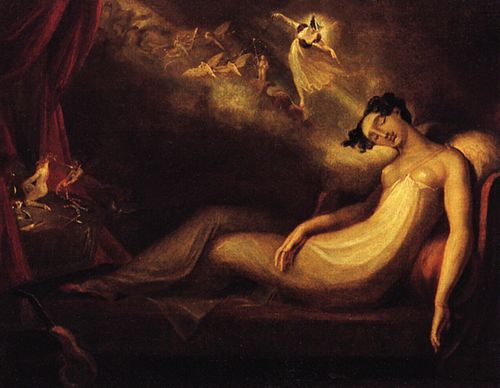Annotation:Air in Queen Mab: Difference between revisions
(Created page with "__NOABC__ <div class="noprint"> <p><font face="sans-serif" size="4"> Back to [[{{BASEPAGENAME}}]] </font></p> </div> ---- {{#lst:{{PAGENAME}}|abc}} ---- <div style="page-break...") |
m (Text replacement - "<div style="text-align: justify; direction: ltr; margin-bottom: 90px; margin-left: 70px; margin-right: 120px;">" to " <div style="text-align: justify;">") |
||
| (3 intermediate revisions by one other user not shown) | |||
| Line 8: | Line 8: | ||
<div style="page-break-before:always"></div> | <div style="page-break-before:always"></div> | ||
<p><font face="sans-serif" size="3"> | <p><font face="sans-serif" size="3"> | ||
<div style="text-align: justify | <div style="text-align: justify;"> | ||
<br> | <br> | ||
'''AIR IN QUEEN MAB.''' English, Scottish; Air (6/8 time). D Major. Standard tuning (fiddle). AABB. '''Queen Mab''' was a pantomime by Charles Burney | '''AIR IN QUEEN MAB.''' English, Scottish; Air (6/8 time). D Major. Standard tuning (fiddle). AABB. '''Queen Mab''' was a pantomime or an afterpiece (a short play after the mainpiece; in this instance, '''Queen Mab''' was staged after a revival of '''The Beggar's Opera''') written by Charles Burney [https://en.wikipedia.org/wiki/Charles_Burney] (1726-1814) who composed the music, although it also contained music by James Oswald and others) and the actor Henry Woodward and staged in Drury Lane the day after Christmas, 1750. It was advertised: 'A New Entertainment in Italian Grotesque Characters call'd Queen Mab, Harlequin by Mr. Woodward'..." Presumably, the 6/8 jig was a piece from Burney's production. See also James Aird's "[[Dance in Queen Mab]]" and "[[Queen Mab]]" for other tunes associated with the pantomime. | ||
<br> | |||
<br> | |||
[[File:QueenMab.jpg|500px|thumb|left|Queen Mab, by Johann Heinrich Füssli (1741-1825), a Swiss painter who worked primarily in Britain]] Queen Mab [http://en.wikipedia.org/wiki/Queen_Mab] is a fairy who is mentioned in Shakespeare's '''Romeo and Juliet.''' She is associated with dreaming and the production of dreams, and has been described as a midwife to help sleepers 'give birth' to their dreams. | |||
<br> | <br> | ||
</div> | </div> | ||
| Line 22: | Line 25: | ||
</font></p> | </font></p> | ||
<p><font face="sans-serif" size="3"> | <p><font face="sans-serif" size="3"> | ||
<font color=red>''Printed sources''</font> : - | <font color=red>''Printed sources''</font> : - Neil Stewart ('''Select Collection of Scots, English, Irish and Foreign Airs, Jiggs & Marches, vol. 1'''), 1784; p. 6, p. 12. | ||
<br> | <br> | ||
<br> | <br> | ||
Latest revision as of 17:05, 11 June 2019
X:1 T:Air in Queen Mab M:6/8 L:1/8 R:Air B:Neil Stewart – “Select Collection of Scots, English, Irish and Foreign B:Airs, Jiggs & Marches, vol. 1” (1784, p. 6, No. 12) Z:AK/Fiddler’s Companion K:D a3 {g}f>ed|(fb)b b2d'|(af).a (ge).g|(fdf) {f}e3| a3 {g}f>ed|(fb).b b2d'|aff gea|fdd d3:| |:(fa2) Te3|(fa2) Te3|(fa).a ^gbd'|c'aa a2 (b/c'/| d'2) (a/f/ b2) (g/e/|a2) (f/d/ g2) (e/c/|d2)b a2b|(ag).f {f}e2A| d3 {f}e>de|(fd').d' d'2b|aff gea|fdd d3:|]
AIR IN QUEEN MAB. English, Scottish; Air (6/8 time). D Major. Standard tuning (fiddle). AABB. Queen Mab was a pantomime or an afterpiece (a short play after the mainpiece; in this instance, Queen Mab was staged after a revival of The Beggar's Opera) written by Charles Burney [1] (1726-1814) who composed the music, although it also contained music by James Oswald and others) and the actor Henry Woodward and staged in Drury Lane the day after Christmas, 1750. It was advertised: 'A New Entertainment in Italian Grotesque Characters call'd Queen Mab, Harlequin by Mr. Woodward'..." Presumably, the 6/8 jig was a piece from Burney's production. See also James Aird's "Dance in Queen Mab" and "Queen Mab" for other tunes associated with the pantomime.

